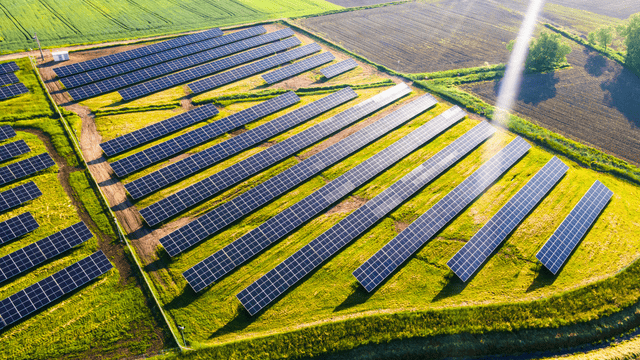The Rise of Commercial Solar Systems
As businesses increasingly prioritise sustainability and energy efficiency, commercial solar power has become an attractive investment.
With rising electricity costs and growing concerns about carbon footprints, solar energy offers a viable solution for reducing operational expenses while promoting environmental responsibility.
This article explores what commercial solar systems are, the different applications available, their benefits, the installation process, and different funding options available.
What Is A Commercial Solar System?
A commercial solar system is a photovoltaic (PV) system designed for businesses, industrial facilities, and large-scale operations to generate electricity from sunlight.
They work by utilising photovoltaic panels which absorb sunlight and convert it into direct current (DC) electricity.
A solar inverter then transforms the DC electricity into alternating current (AC), making it compatible with business operations and the electrical grid.
The generated electricity is then used to power the facility, and any excess energy can be stored in batteries or exported back to the grid (via net metering).
Different Applications
Commercial solar systems come in various configurations, each designed to suit different business needs, locations, and energy consumption patterns.
Rooftop solar systems are the most common type of commercial solar installation as these systems utilise unused roof space to generate electricity and can be tailored to meet a business’s energy demands. These are typically installed on warehouses, manufacturing facilities, offices, hotels & educational premises.
Ground-mounted solar systems are ideal for businesses with ample land, and they can be fixed or designed with tracking technology to follow the sun’s movement. These are typically installed on farms, landfill sites, business parks, data centres and solar farms.
Solar carports are a dual-purpose solution, providing shade for vehicles while generating electricity. These structures are popular in commercial parking lots and can help businesses optimise space utilisation.
Emerging technologies, such as floating solar farms and hybrid systems with battery storage, further enhance the flexibility and efficiency of solar power adoption.
Benefits of Commercial Solar Systems
- Cost Savings – One of the most significant advantages of commercial solar systems is the potential for substantial cost savings on energy bills. By generating electricity on-site, businesses can reduce reliance on the grid, mitigate price fluctuations, and, in some cases, eliminate energy costs altogether.
- Environmental Benefits – Solar energy is a clean and renewable source of power that significantly reduces greenhouse gas emissions. By switching to solar, businesses can lower their carbon footprint and contribute to global sustainability goals.
- Energy Independence – With solar panels in place, businesses can become more self-reliant regarding their energy supply. Battery storage solutions further enhance independence by storing excess power for use during peak demand periods or grid outages.
- Enhanced Corporate Reputation – Sustainability initiatives, including solar energy adoption, improve a company’s public image. Customers and stakeholders are increasingly favoring businesses that demonstrate environmental responsibility.
- Increased Property Value – Commercial properties with solar installations often see an increase in market value, as energy-efficient buildings are more attractive to buyers and tenants looking to reduce operational costs.
- Government Incentives – Schemes such as the Smart Export Guarantee (SEG) pay eligible businesses for surplus energy exported back to the grid (only available through certain energy suppliers).
The Installation Process
Installing a commercial solar system involves a structured approach to ensure a smooth process, minimising downtime and maximising long-term energy savings.

Different Funding Options
There are several funding options available for commercial solar installations, each with its own advantages:
Outright Purchase (CapEx Investment)
- The business funds the solar installation upfront, owning the system outright.
- Benefits include full access to savings on electricity bills and potential tax incentives such as the Super Deduction or Annual Investment Allowance (AIA).
- Offers the fastest return on investment.
Power Purchase Agreement (PPA)
- A third party funds, owns, and maintains the solar system, while the business agrees to buy the electricity generated at a lower-than-grid rate.
- No upfront cost, but long-term savings may be lower than outright ownership.
- Typically involves contracts of 10–25 years.
Lease (Solar Leasing)
- Similar to a PPA, but instead of paying for energy, the business pays a fixed monthly fee to use the system.
- Lower initial costs than purchasing but does not offer the benefits of full ownership.
Green Loans & Asset Finance
- Businesses can finance the system via loans, asset finance, or hire purchase agreements.
- Allows spreading the cost over several years while still benefiting from ownership and tax incentives.
Conclusion
Investing in commercial solar energy offers long-term financial, environmental, and strategic advantages for businesses.
With evolving technology, growing incentives, and increasing sustainability demands, now is an excellent time for businesses to explore solar energy as a viable and profitable solution.
We specialise in providing turn-key commercial solar solutions tailored to your businesses requirements.
Contact us today to explore how we can help your business achieve energy independence and long-term sustainability.
